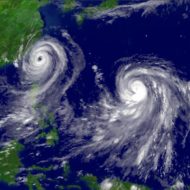000 WTPZ42 KNHC 260856 CCA TCDEP2 Tropical Depression Seven-E Discussion Number 1...Corrected NWS National Hurricane Center Miami FL EP072022 400 AM CDT Tue Jul 26 2022 Conventional satellite imagery shows that deep convection associated with the low pressure area south of southern Mexico has continued to increase and become better organized. An earlier SSMIS microwave overpass revealed an improved low-level structure, although most of the deep convection was located over the western portion of the system due to moderate easterly shear. A couple of scatterometer overpasses between 0330 and 0500 UTC showed that the circulation had become much better defined and the system had peak winds around 30 kt. Subjective Dvorak T-numbers from SAB and TAFB have also increased to T2.0, and based on all the above data, advisories are being initiated on Tropical Depression Seven-E. The initial wind speed is set at 30 kt, in agreement with both the ASCAT data and the subjective Dvorak estimates. Moderate easterly shear is forecast to plague the system over the next 24 to 48 hours, however most of the intensity guidance suggests gradual strengthening will occur during that time. The official forecast follows suit and calls for the depression to become a tropical storm later today or tonight. After 48 hours, the shear is expected to abate while the system is over SSTs of 28-29C and within a moist low- to mid-level environment. Those conditions favor a faster rate of strengthening, and this is reflected in the NHC forecast which shows the system becoming a hurricane in about 72 hours. The intensity forecast is in good agreement with the HCCA and IVCN consensus aids and is also supported by the global model guidance which depicts more significant deepening in 2-3 days. The initial motion estimate is a somewhat uncertain 280/10 kt. The cyclone is expected to continue westward for the next few days while it is steered by a subtropical ridge that extends westward from northern Mexico. After that time, the GFS and ECMWF models develop a slight weakness in the ridge off the coast of Baja California which allows the system to turn west-northwestward. The UKMET depicts a stronger ridge and a more westward track than the remainder of the guidance and its ensemble mean. As a result, the official forecast is closer to a blend of the GFS and ECMWF models, and a bit north and east of the TVCE multi-model consensus. FORECAST POSITIONS AND MAX WINDS INIT 26/0900Z 11.4N 101.8W 30 KT 35 MPH 12H 26/1800Z 11.8N 103.6W 35 KT 40 MPH 24H 27/0600Z 12.1N 105.6W 40 KT 45 MPH 36H 27/1800Z 12.2N 107.4W 45 KT 50 MPH 48H 28/0600Z 12.5N 109.1W 50 KT 60 MPH 60H 28/1800Z 12.8N 110.8W 60 KT 70 MPH 72H 29/0600Z 13.3N 112.6W 70 KT 80 MPH 96H 30/0600Z 14.9N 116.2W 80 KT 90 MPH 120H 31/0600Z 17.5N 119.7W 80 KT 90 MPH $$ Forecaster Brown
